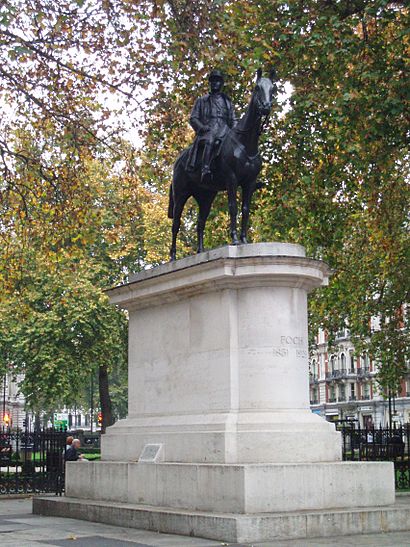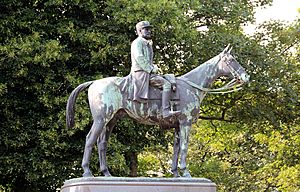Equestrian statue of Ferdinand Foch, London facts for kids
Quick facts for kids Equestrian statue of Ferdinand Foch |
|
|---|---|
 |
|
| Artist |
|
| Completion date | 1930 |
| Type | Sculpture (Equestrian statue) |
| Medium | Bronze |
| Subject | Ferdinand Foch |
| Dimensions | 3.20 m (10.5 ft) |
| Location | Grosvenor Gardens, London |
| 51°29′47″N 0°08′43″W / 51.4964°N 0.14525°W | |
|
Listed Building – Grade II
|
|
| Official name | Statue of Marshal Foch |
| Designated | 24 February 1958 |
| Reference no. | 1066732 |
The Equestrian statue of Ferdinand Foch stands in Lower Grosvenor Gardens, London. An "equestrian statue" means it shows a person riding a horse. This statue was made by Georges Malissard. It is a copy of another statue in Cassel, France.
Ferdinand Foch was a very important French military leader. In 1918, he became the top commander for all the Allied forces fighting on the Western Front. Many people thought he was the main reason Germany lost World War I in November 1918. He received many honors, including becoming an honorary Field Marshal in the British Army. He was the only French commander to get this special award. After Foch passed away in March 1929, people wanted to build a statue in London to remember him. The Foch Memorial Committee chose Malissard to create it. The statue was officially revealed by the Prince of Wales on June 5, 1930. It was given a special protection status in 1958, and its importance was raised even higher in 2016.
Who Was Ferdinand Foch?
Ferdinand Foch (1851–1929) started his military career as a soldier. This was during the Franco-Prussian War in 1870. He quickly moved up in rank during World War I. In March 1918, he was made the Supreme Allied Commander. This meant he was in charge of all the Allied armies on the Western Front.
In the months that followed, the Allied forces became more successful. They eventually defeated Germany. Many leaders, including the British Prime Minister David Lloyd George, believed Foch's plans were key to this victory. In November 1918, Foch accepted Germany's surrender. He signed the Armistice of 11 November 1918 for the Allied nations. This important event happened in a railway car in the Forest of Compiegne.
Why Was the Statue Built?
Foch received many awards from France and other countries. The British government gave him the Order of Merit. They also made him an honorary Field Marshal. After Foch died in March 1929, a British official named Lord Askwith started a committee. This group, called the Foch Memorial Committee, planned and raised money for a memorial.
The French sculptor Georges Malissard was asked to make the statue. He agreed to create a copy of an earlier statue he had made of Foch in Cassel, France. Some people did not like the idea of using a copy of a French statue by a French artist. The head of the Royal British Society of Sculptors even wrote to The Times newspaper to complain. The head of the Royal Fine Art Commission privately called the design "very poor." However, the committee went ahead with the plan. This was partly because it was cheaper to make a copy.
The statue was first planned for the northern part of Grosvenor Gardens. But Malissard wanted it further south. He thought French visitors arriving at Victoria Station would see it better there. Victoria Station was where fancy trains from France arrived. The statue was officially revealed on June 5, 1930. Edward, Prince of Wales, led the ceremony. Many important people were there, including Lloyd George and other military officers from Britain and France.
Special events are still held at the statue. In November 2014, it was rededicated. On March 26, 2018, a ceremony marked 100 years since Foch became Supreme Allied Commander.
What Does the Statue Look Like?
The statue itself was designed by Georges Malissard. The base, called a plinth, was designed by architect Paul Lebret. The statue is made of bronze and is 3.2 meters (about 10.5 feet) tall. The stone base is 3.85 meters (about 12.6 feet) high.
Foch is shown wearing his military uniform. He is sitting on top of a horse. The stone base has three messages carved into it. The front says "Foch" and gives the years he was born and died. The right side says: "I am conscious of having served England as I served my own country". The back lists Foch's highest military ranks and awards.
After World War II, the area around the statue was made into a garden. It was designed in the French style. This garden was dedicated to Foch's memory in 1952. The country of France paid for the garden. The statue and its setting are considered historically important. In 1958, the statue was given a special "Grade II listed structure" status. This was upgraded to "Grade II*" in 2016. This means it is a very important historical monument.


